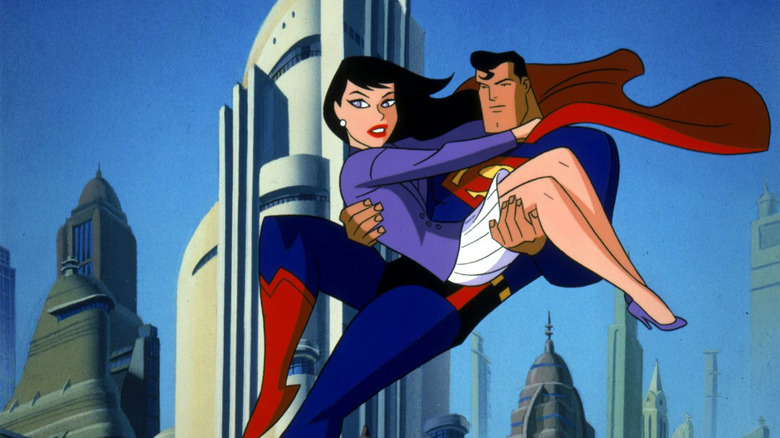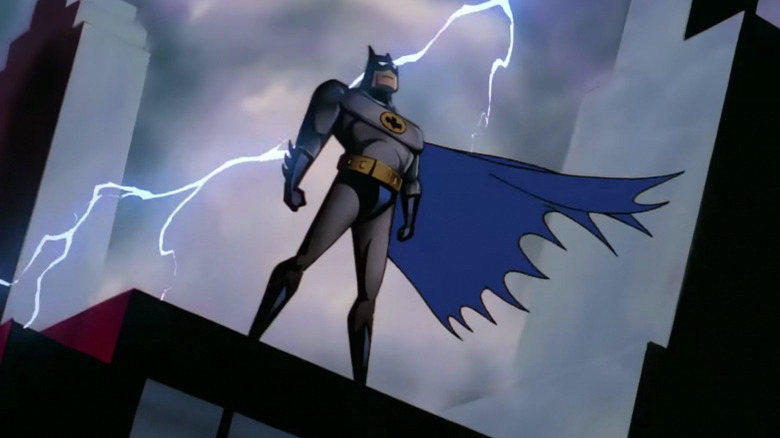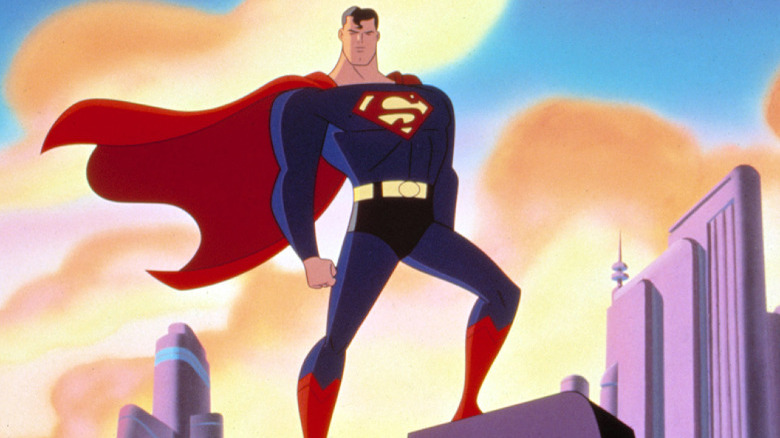Why Superman And Batman: The Animated Series Seem To Be Set In Different Eras
"Batman: The Animated Series" didn't look like any other Saturday morning cartoon of its time. Instead of building on the light Hanna-Barbera stylings of "Super Friends", the show's creative team aped aesthetic styles from the early 20th century. "BTAS" mixed the shadows of film noir and the architecture of art deco; producer Alan Burnett called this combination "Dark Deco" while writer Paul Dini said Gotham City was meant to look like, "What if the 1939 World's Fair had gone on another 60 years or so?" This meant modern computers being used alongside black-and-white TVs, not to mention cars and clothing cribbed from the 1940s.
However, when the same team got the chance to adapt Superman, they knew a different style was needed. Not just because the Man of Steel would feel out of place in a darker world, but because they didn't want to be compared to the Fleischer Studios Superman cartoons of the 1940s. In an interview with Comic Book Resources, "Superman: The Animated Series" producer Bruce Timm explained:
"With Batman, we could borrow a lot of those Fleischerisms because they were a perfect fit for Batman — they were almost a better fit for Batman than Superman — because there was a lot of dark, German Expressionism in the staging in the Fleischer Superman cartoons that was totally applicable to Batman. But I also didn't want to go back to that same palette because I wanted to do something slightly different than 'Batman: The Animated Series.' I sure didn't want to do a half-assed knock-off of the Fleischer Superman cartoons because there's a direct comparison there."
How Superman compared
While Gotham City felt like a place out of time, the Metropolis of "Superman: The Animated Series" could pass as contemporary. The characters' fashion choices were modern and the art design had more even lighting than in "Batman: The Animated Series." If anything, "STAS" had a futuristic, sci-fi bent to it, especially in the architecture of Metropolis and in stories featuring robots and aliens. Naturally, science fiction better fits Superman (who's not from Earth himself) than it does Batman.
Bruce Timm elaborated on the logic behind this choice in his interview with Comic Book Resources:
"We figured it would be better to do something fresher, so ['Superman'] incorporated some of the design elements from 'BTAS,' but also by setting it in a much less retro world, with slightly futuristic cars and more modern fashions and hairstyles, it gave it a little bit more of a timeless feel of its own that didn't look specifically tied to any one era."
Batman was stuck in the past while Superman looked towards the future. That encapsulation of their characters is what guided the different looks of their respective animated shows.
Choosing one over the other
I personally prefer the "Batman: The Animated Series" aesthetic, as I find it more striking and unique. The "Superman: The Animated Series" aesthetic isn't bad but compared to "Batman," it just looks more like a normal cartoon.
However, it's the Superman look that won out in the end. When Batman visited Metropolis in the "STAS" episode "World's Finest," he and the Joker were designed with sharper outlines to fit Superman's world. That redesign was subsequently used as the basis for "The New Batman Adventures," in which Gotham itself lost some of the "dark deco" mood and looked more like a modern city (with 1990s fashion, cars, and color TVs). These shows later gave rise to the animated "Justice League" series, which once again opted for the brighter aesthetic of "STAS," albeit with smoother digital coloring.
This leaves "Batman: The Animated Series" as the visual oddball out of the DC Animated Universe. While I do miss the rounder character designs and more fluid animation of "BTAS" in the later shows, I understand the need for an aesthetic update. "Dark deco" is perfect for Batman, but stick Wonder Woman, the Flash, Green Lantern, and yes, Superman in that sort of environment and they'll look out of place.


